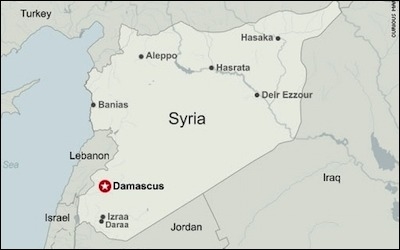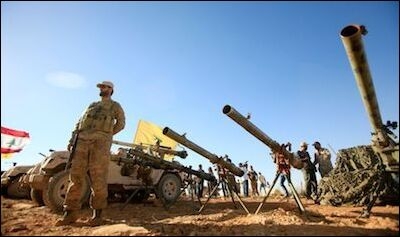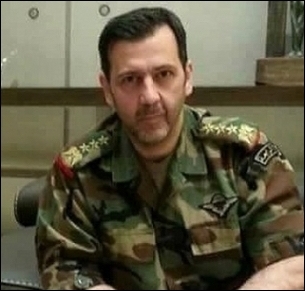by Jonathan Spyer, JPOST

The global spotlight has currently returned to Syria because of the Assad regime’s current bloody offensive in Idlib, Aleppo and Latakia provinces. The regime is trying to reduce the last enclave held by Sunni Arab rebels in the country’s northwest.
The assault has precipitated one of the worst humanitarian disasters of the bloody, nine-year war. Eight hundred thousand people have left their homes to flee the advance of regime forces and the relentless, indiscriminate bombing of Assad’s Russian allies.
Far to the south of Idlib, however, and largely ignored by the global media, events are under way that may offer a clue to the future direction of Syria. These events are of direct interest to Israel.
The regime is currently seeking to consolidate its presence in Deraa and Quneitra provinces in Syria’s southwest. Assad’s army completed its “conquest” of these areas in the summer of 2018.
| The Syrian regime reconquered the southwest in 2018, but the region is still not silenced. |
Observation of the current situation on the ground in these areas suggests, however, that the situation remains far from a return to the repressive and stifling order of the pre-revolt days.
Rather, the situation is characterized on the one hand by extensive Iranian and Hezbollah activity within the empty shell of the government’s structures, and on the other hand by an ongoing, armed resistance to that government. The precise organization, origins and nature of this resistance remain somewhat mysterious. But the tempo of attacks on regime positions and facilities is relentless, and increasing.
 Hezbollah forces stationed at Juroud Arsal along the Syrian-Lebanese border. Hezbollah forces stationed at Juroud Arsal along the Syrian-Lebanese border. |
Deraa is where the Syrian rebellion broke out, in distant early 2011. Nine years on, it is not yet silenced. Rather, the area and its environs increasingly constitute Syria’s wild southwest.
Regarding Iranian and Hezbollah activity, the extensive human infrastructure maintained by Iran and its proxy in southwest Syria has been well documented.
In a recent report produced by the Jerusalem Center for Public Affairs (JCPA), Brig.-Gen. (ret.) Shimon Shapira and Col. (ret.) Jacques Neriah noted that since the return of the area to regime control, Hezbollah has been actively recruiting. The recruits come from among the area’s impoverished Sunni communities. They are tempted into the ranks by financial inducements. Hezbollah pays $250 a month, according to Shapira and Neriah. Three thousand five hundred local Syrians have been recruited in this way since mid-2018, according to the report.
| Hezbollah commanders are recruiting impoverished Sunnis in the Golan Heights. |
They further note that the Hezbollah commander behind these efforts is 50-year-old Munir Naima Ali Shaito, known as Haj Hashem. Shaito is a veteran and senior Hezbollah operative, and is former deputy commander of the elite Badr unit within the organization.
The Syrian Observatory for Human Rights, a pro-opposition but generally reliable source, reported this week that Iran-backed militia commanders have begun to offer financial incentives to the mukhtars of villages in the Syrian-controlled part of the Golan, in return for their cooperation in recruiting village youth to the militias’ ranks. Among the villages named by the observatory are al-Habiriyah and Sultanah.
Iranian efforts in this area are not taking place in isolation from the official regime structures. Rather, in the manner Tehran favors, its operatives both cooperate with regime forces and operate from within them.
 Maher Assad, Iran’s chosen partner in southwest Syria. Maher Assad, Iran’s chosen partner in southwest Syria. |
The powerful Air Force Intelligence Directorate and the 4th Armored Division, commanded by Bashar Assad’s brother Maher, are the Islamic Revolutionary Guard Corps’ chosen partners in southwest Syria. Hezbollah maintains an intelligence gathering facility within a base of the Syrian Arab Army’s 90th Brigade in the Hadr area, very close to the border with Israel, according to the JCPA report.The implications of this information are significant. The notion that an unproblematic return of the antebellum status quo and of the strong prewar Baathist state is taking place in areas where the regime has replanted its flag needs to be complicated. What is returning is something different – namely, the shell of the prewar regime, within which Iran and its allies appear to have unfettered freedom of action.
They are not having things all their own way, though. Since June 2019, according to the observatory, more than 300 attacks have taken place on regime and allied forces in the Deraa area. These have included shootings, and detonations of IEDs and mines. One hundred ninety-two people have been killed in these attacks, including 36 civilians and 100 members of the regime forces, and its “loyalists and collaborators,” according to the observatory.
| Attacks on regime forces and facilities in the southwest have increased since June 2019. |
The latest attacks came this week, when unidentified gunmen fired on an Air Force Intelligence checkpoint at the southern entrance to al-Musayfirah town in Deraa’s eastern countryside.
The precise figures produced by the observatory should be treated with some skepticism. Southwest Syria is closed to media coverage and so there is no way of verifying these. But the ongoing attacks on regime forces and facilities are confirmed from other sources and are not in doubt.
So what is behind these actions?
Haid Haid, a respected Syrian researcher on the war, notes that the regime’s continued arrests and violations of amnesty agreements with locals may be motivating the return to resistance.
An organization calling itself Popular Resistance (Al-Muqawama al-Sha’abia) has emerged and has begun to claim responsibility for the attacks. The group, as reported by Haid, gave an interview to an Arabic news site in November, declaring war on the regime and its associated militias. In the interview the spokesman, calling himself Saif al-Horani, said that the group has no affiliation with any foreign state or entity.
Haid notes, however, that no further information is available on this group. Doubts have emerged whether it exists at all, or whether it is simply an effort to take credit for acts committed by others. There is also the possibility that the overt “leadership” of Popular Resistance is an attempt by the regime to draw its opponents in Deraa into the daylight, so that they can be neutralized.
Identifying those behind Popular Resistance is important. A question of particular interest will be the role of Sunni jihadis affiliated with Islamic State or Hayat Tahrir al-Sham in these actions. No evidence of either has emerged as yet. The perpetrators remain shrouded in mystery. But the attacks are continuing and increasing.
| In the southwest, a failed state penetrated by outside powers faces an inchoate but deadly insurgency. |
Events in Syria’s southwest matter for Israel because the chaos and the continued weakness of the Syrian state allow Iran to advance by stealth, organizing in the direction of Israel’s border.
More broadly, Deraa and Quneitra are worth watching with care, because they show that contrary to the impression conveyed in regime and Russian propaganda, normality is not returning to Syria with the advance of the regime’s flag.
Rather, in Syria’s wild southwest, what exists is a chaotic failed state, thoroughly penetrated by outside powers, and facing an ongoing, inchoate but deadly insurgency at the hands of those it claims to have vanquished.
Jonathan Spyer is director of the Middle East Center for Reporting and Analysis and is a research fellow at the Middle East Forum and at the Jerusalem Institute for Security and Strategy.



Leave a Reply
You must be logged in to post a comment.